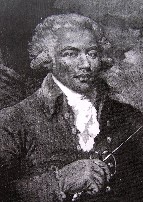Allegro
The Black Knight
Saint-Georges, the First Classical Composer of African Descent
Volume CVII, No. 2February, 2007
 |
It was around 1970, shortly before I joined the New York Philharmonic, while prowling the libraries for unfairly neglected violin music to vary my repertoire, that I first came across a score by a composer of the elegant but unfamiliar name of Saint-Georges.
His music must have left a lasting impression on me, for in 1980 I devoted the third volume of my anthology, “Masters of the Violin,” to his works. It turns out that he was actually a “chevalier” (knight, in French), with the full grand name and title of Joseph Bologne, the Chevalier de Saint-Georges.
Not until then did I realize that Saint-Georges was black. Later, preparing an article for Black Music Research Journal (Nov. 1990), I became aware of significant errors marring his history, including the year of his birth (he was actually born in 1745 and died in 1799), his father’s identity, his education, and his character. Most of the errors originated with a 19th-century novel, blithely accepted as fact by music historians.
Joseph was born on the island of Guadeloupe of an African slave and a French colonial planter. At age seven, his fond father took the boy, his only son, to Paris and eventually enrolled him in La Boëssière’s elite fencing academy. A natural all-around athlete, “at fifteen Joseph beat all challengers,” including Picard, a Rouen fencing master who called him disdainfully “Boëssière’s mulatto.”
That match earned him a commission in the gendarmes (bodyguards) of Louis XV, which included the title of chevalier (knight). He became known as the chevalier “de Saint-Georges,” after his father. Thus began the young “mulatto’s” unparalleled rise in elite Paris society, and at court in Versailles. Handsome, gallant, a great dancer, he was welcome in the salons — and boudoirs — of the great hostesses.
Not until 1764 — when compositions dedicated to him began to appear — did anything connect Saint-Georges with music. Thus, Paris was astonished to find their famous fencer playing the violin in Gossec’s prestigious Orchestre des Amateurs. In 1773, as its concertmaster, he performed two concertos of his own composition and when Gossec took over the Opéra, Saint-Georges became director of the Amateurs. In 1776 he renounced directing the Opéra when a trio of divas “refused to serve under a Mulatto.” As conductor of the Masonic Concert Olympique, (successor of the defunct Amateurs) Saint-Georges commissioned and premiered Haydn’s six “Paris” symphonies. Marie-Antoinette, who frequented his concerts, invited him to join her in her musicales.
Believing that it would end slavery, he supported the Revolution, first serving as secret agent of the Duke of Orléans (later Philippe Egalité), then joining the National Guard. Appointed colonel of an all-black hussar regiment, the first in modern history, he fought on the northern front, but was arrested and imprisoned without charge under the paranoia of the Great Terror. Freed after the fall of Robespierre, he lost his fight to regain his regiment. Disillusioned, he embarked for Saint-Domingue (Haiti) where Toussaint Louverture’s black army was fighting against slavery. Back in Paris Saint-Georges received his last acclaim conducting the orchestra of the Cercle de L’Harmonie, another Masonic organization.
He died in Paris, June 1799, at age 53.
During his relatively short musical career Saint-Georges composed 18 string quartets, 9 sonatas, 14 violin concertos, 8 symphonies concertantes, two symphonies, 6 opéra comiques, and airs and romances. A particularly important contribution to posterity was his innovative violin technique. First to fully recognize the possibilities of the modern bow, he grafted the technique of the Italian baroque virtuosi, Vivaldi, Geminiani, Locatelli and Tartini, to the violin writing of Beethoven, Brahms and Paganini. His bowing technique is still valid today.
In 1999, Paris celebrated the bicentennial of the death of Saint-Georges: virtuoso fencer, violinist and composer. The anniversary gave rise to a spectacular revival of his music. I feel privileged that a 20-year head start enabled me to restore the truth to Saint-Georges’ image.
Gabriel Banat is a member of Local 802. He is the author of “The Chevalier de Saint-Georges, Virtuoso of the Sword and the Bow” (Pendragon Press, June 2006), which Today’s Books applauded as “A must read!” Chamber Music magazine wrote that “Banat’s splendid study will serve as the vade mecum.” He can be reached at dbanat@hotmail.com.
